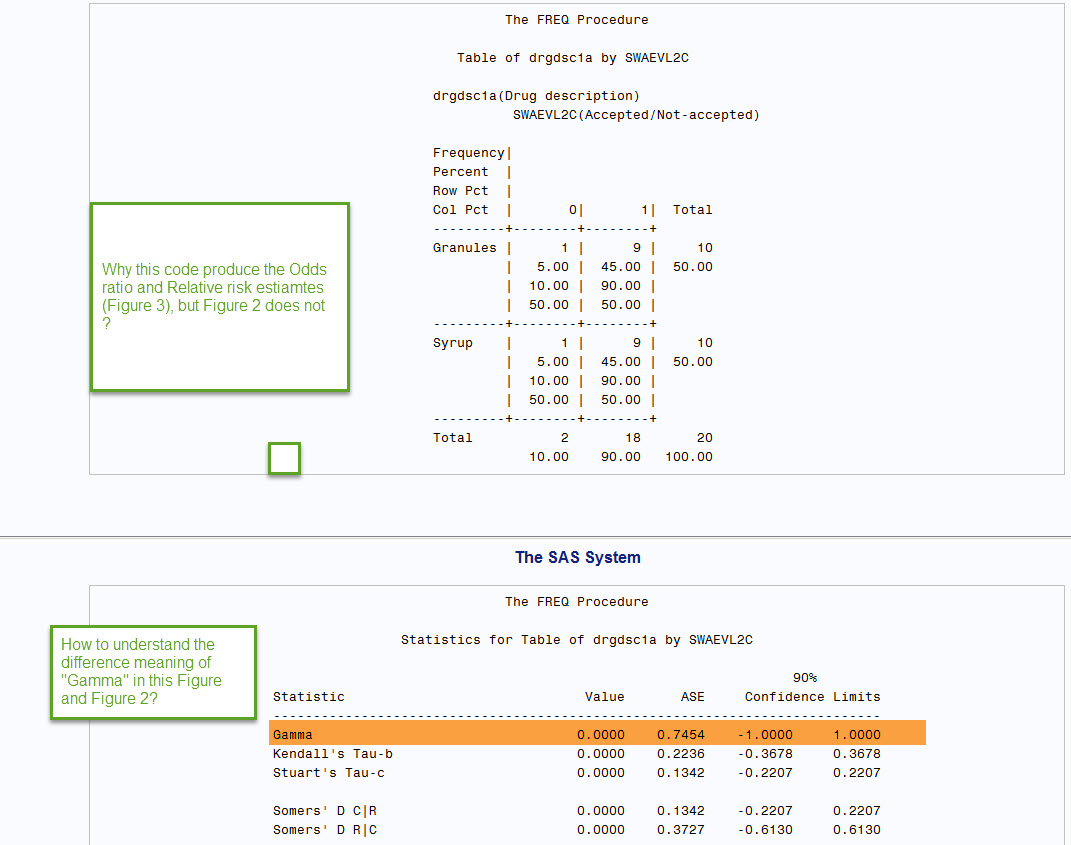- Home
- /
- Analytics
- /
- Stat Procs
- /
- How to understand the great difference value of Gamma in PROC FREQ?
- RSS Feed
- Mark Topic as New
- Mark Topic as Read
- Float this Topic for Current User
- Bookmark
- Subscribe
- Mute
- Printer Friendly Page
- Mark as New
- Bookmark
- Subscribe
- Mute
- RSS Feed
- Permalink
- Report Inappropriate Content
Dear ALl,
I have question regard to the difference of Gamma in Figure 1 and Figure 2. How to interpret them and what is the difference?
The other question is why Figure 1 code produce the Odds ratio and Relative risk estimates but not the Figure 2 code?
Thanks
/*Figure 1*/
proc freq data=dar_grp5;
tables Treatment*SWAEVL2C/measures alpha=0.1 CL;
run;
/*Figure 2*/
proc freq data=compare;
tables SWAEVL2C_gra*SWAEVL2C_syr/measures alpha=0.1 CL;/*SWAEVL2C_gra is the results for granules and SWAEVL2C_Syr is for Syrup*/
run;Accepted Solutions
- Mark as New
- Bookmark
- Subscribe
- Mute
- RSS Feed
- Permalink
- Report Inappropriate Content
The formulas for these statistics are shown in the "Measures of Association" section of the PROC FREQ doc.
For the first TABLES statement:
C = number concordant = 10;
D = number discordant = 10;
Therefore Gamma = (C-D)/(C+D) = 0.
For the second TABLES statement:
C = 10;
D = 0;
Gamma = (C-D)/(C+D) = 1.
The odds ratio formula is also in the doc.
OR = n11 * n22 / (n12 * n21)
In the second run, the off diagonal counts are zero. therefore the odds ratio is undefined.
The RR computation is similar, and also undefined in the second situation.
- Mark as New
- Bookmark
- Subscribe
- Mute
- RSS Feed
- Permalink
- Report Inappropriate Content
The formulas for these statistics are shown in the "Measures of Association" section of the PROC FREQ doc.
For the first TABLES statement:
C = number concordant = 10;
D = number discordant = 10;
Therefore Gamma = (C-D)/(C+D) = 0.
For the second TABLES statement:
C = 10;
D = 0;
Gamma = (C-D)/(C+D) = 1.
The odds ratio formula is also in the doc.
OR = n11 * n22 / (n12 * n21)
In the second run, the off diagonal counts are zero. therefore the odds ratio is undefined.
The RR computation is similar, and also undefined in the second situation.
- Mark as New
- Bookmark
- Subscribe
- Mute
- RSS Feed
- Permalink
- Report Inappropriate Content
In addition to Rick's comments, the Gamma, OR, and RR, and confidence limits are all based on asymptotic theory, so they should not be used with sample sizes this small. PROC FREQ has a number of EXACT tests that are more appropriate.
- Mark as New
- Bookmark
- Subscribe
- Mute
- RSS Feed
- Permalink
- Report Inappropriate Content
Thanks for your comment. I fully agree.

The 2025 SAS Hackathon has begun!
It's finally time to hack! Remember to visit the SAS Hacker's Hub regularly for news and updates.
ANOVA, or Analysis Of Variance, is used to compare the averages or means of two or more populations to better understand how they differ. Watch this tutorial for more.
Find more tutorials on the SAS Users YouTube channel.





